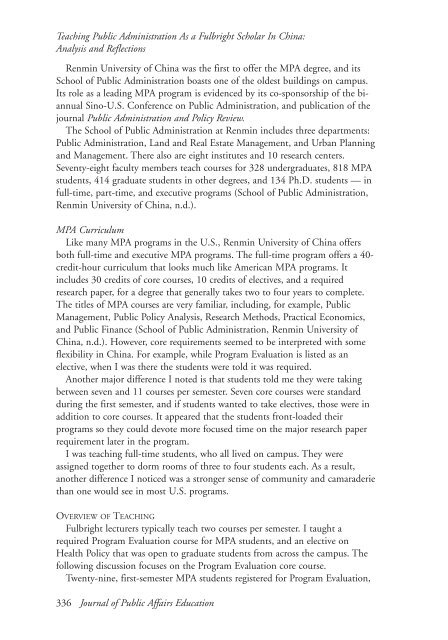journal of public affairs education - NASPAA *The Global Standard ...
journal of public affairs education - NASPAA *The Global Standard ...
journal of public affairs education - NASPAA *The Global Standard ...
- No tags were found...
Create successful ePaper yourself
Turn your PDF publications into a flip-book with our unique Google optimized e-Paper software.
Teaching Public Administration As a Fulbright Scholar In China:Analysis and ReflectionsRenmin University <strong>of</strong> China was the first to <strong>of</strong>fer the MPA degree, and itsSchool <strong>of</strong> Public Administration boasts one <strong>of</strong> the oldest buildings on campus.Its role as a leading MPA program is evidenced by its co-sponsorship <strong>of</strong> the biannualSino-U.S. Conference on Public Administration, and <strong>public</strong>ation <strong>of</strong> the<strong>journal</strong> Public Administration and Policy Review.The School <strong>of</strong> Public Administration at Renmin includes three departments:Public Administration, Land and Real Estate Management, and Urban Planningand Management. There also are eight institutes and 10 research centers.Seventy-eight faculty members teach courses for 328 undergraduates, 818 MPAstudents, 414 graduate students in other degrees, and 134 Ph.D. students — infull-time, part-time, and executive programs (School <strong>of</strong> Public Administration,Renmin University <strong>of</strong> China, n.d.).MPA CurriculumLike many MPA programs in the U.S., Renmin University <strong>of</strong> China <strong>of</strong>fersboth full-time and executive MPA programs. The full-time program <strong>of</strong>fers a 40-credit-hour curriculum that looks much like American MPA programs. Itincludes 30 credits <strong>of</strong> core courses, 10 credits <strong>of</strong> electives, and a requiredresearch paper, for a degree that generally takes two to four years to complete.The titles <strong>of</strong> MPA courses are very familiar, including, for example, PublicManagement, Public Policy Analysis, Research Methods, Practical Economics,and Public Finance (School <strong>of</strong> Public Administration, Renmin University <strong>of</strong>China, n.d.). However, core requirements seemed to be interpreted with someflexibility in China. For example, while Program Evaluation is listed as anelective, when I was there the students were told it was required.Another major difference I noted is that students told me they were takingbetween seven and 11 courses per semester. Seven core courses were standardduring the first semester, and if students wanted to take electives, those were inaddition to core courses. It appeared that the students front-loaded theirprograms so they could devote more focused time on the major research paperrequirement later in the program.I was teaching full-time students, who all lived on campus. They wereassigned together to dorm rooms <strong>of</strong> three to four students each. As a result,another difference I noticed was a stronger sense <strong>of</strong> community and camaraderiethan one would see in most U.S. programs.OVERVIEW OF TEACHINGFulbright lecturers typically teach two courses per semester. I taught arequired Program Evaluation course for MPA students, and an elective onHealth Policy that was open to graduate students from across the campus. Thefollowing discussion focuses on the Program Evaluation core course.Twenty-nine, first-semester MPA students registered for Program Evaluation,336 Journal <strong>of</strong> Public Affairs Education
















